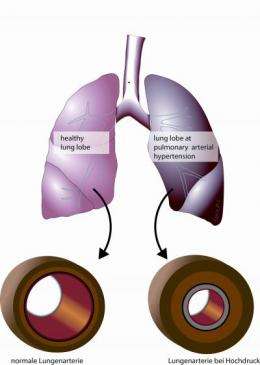When the lungs come under pressure

German scientists have found a way of treating pulmonary arterial hypertension.
Patients with pulmonary arterial hypertension struggle with severe symptoms, which include shortness of breath, exhaustion and a lack of vitality. Moreover, the disease, which is more common in women, often claims the patient's life within a few years of its development. The currently available methods of treatment can slow down the progression of the disease and improve the symptoms; a cure, however, has thus far been unavailable. Scientists from the Max Planck Institute for Heart and Lung Research and Giessen University have now succeeded - for the first time in an animal model - in not only halting the progression of the disease, but also in reversing it with the help of an inhalation therapy.
A malfunction of the vascular endothelium arises at an early stage in the development of pulmonary arterial hypertension. The endothelium is the interior layer of blood vessels, which has an optimal smooth surface and hence ensures low-friction blood flow. In addition, the endothelium regulates the diameter of the blood vessels and adapts the distribution of the blood to the body's functional requirements. The blood vessel growth is also controlled by the endothelium. With pulmonary arterial hypertension, the malfunctioning of the vascular epithelium results in the contraction and narrowing of the blood vessels. In addition, the blood vessel walls thicken as a result of the pathological proliferation of the blood vessel wall cells, which leads to the further obstruction of blood flow. The heart must pump harder to counteract this resistance thus causing, in turn, pathological changes in the right ventricle that ultimately lead to the development of the condition known as right heart failure.
Under normal circumstances, the entire system is held in balance by just a few factors; nitric oxide plays a central role in the maintenance of this balance. "We have been aware of the exceptional importance of this gas for the functionality of blood vessels for some years now. It is one of the components that regulate the width of blood vessels and cell proliferation," explains Ralph Schermuly, a research group leader at the MPI. The sudden decline in the production of nitric oxide by the endothelium plays an important role in the development of pulmonary hypertension. This gives rise to the aforementioned effects on the functioning of the blood vessels.
Nitric oxide production takes place as a result of various biochemical reactions, the regulation of which is extremely complex. The Bad Nauheim-based scientists and their colleagues from the University of Giessen attempted to intervene at a key point in this system. To this end, they had rats, in which pulmonary hypertension had been experimentally induced, repeatedly inhale a nasal spray containing the active ingredient over a period of four weeks. "The effect was impressive. Not only was the disease progression halted, we were also able to observe a clear improvement in all areas," explains Soni Pullamsetti, first author of the study. The normal function of the endothelium was thus restored, cell proliferation in the blood vessel walls decreased significantly and the narrowing of the blood vessels reversed. According to Pullamsetti, these combined effects caused a reduction in the arterial hypertension.
The scientists would now like to carry out further research on the therapeutic potential of their findings. Werner Seeger, Director of the Department of Lung Development and Remodelling at the MPI and Director of the Department of Internal Medicine at University Hospital Giessen sees the potential of the study as relating to the fact that "for the first time, the progression of the disease was not only halted but the structural changes in the blood vessels were also reversed using a locally administered substance." The administration of the treatment in the form of a nasal spray would offer a relatively effortless form of therapy. Moreover, as Seeger goes on to explain, the local administration of the substance would eliminate the otherwise severe side effects. Other studies would have to show, however, whether the results achieved in the animal model are also applicable to human patients. The scientists hope that the basis for the clinical application of the treatment can be established within the next five years.
More information: cAMP Phosphodiesterase Inhibitors Increases Nitric Oxide Production by Modulating Dimethylarginine Dimethylaminohydrolases, DOI: 10.1161/CIRCULATIONAHA.110.941484 , Circulation published online 7 March, 2011















